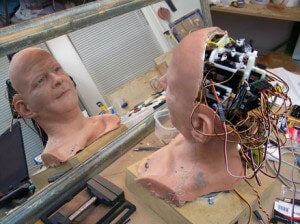Disturbingly Real Replicants from Hanson Robotics

Share
If Disney's Hall of Presidents upset you, if Chuck E. Cheese and his friends frighten you, if the TV show Dinosaurs gave you nightmares - don't read this post! Hanson Robotics is in the business of creating life-like animatronic faces and they've gotten disturbingly real. Complex emotions play across the visages of these robotic replicants and if you're not careful you'll soon buy into their reality. Check out the videos of Hanson's creations after the break.
Dr. David Franklin Hanson, Jr , the founder of Hanson Robotics, owes much of his success to Frubber. Frubber is a revolutionary material with a porous structure that allows it to move similarly to human tissue. Previously used materials were too heavy and too stiff. Using Frubber, Hanson can create a wide range of realistic facial expressions while cutting the need for powerful actuators. Typical applications using Frubber consume more than 20 times less power than with traditional materials. A realistic face and neck can run for hours using just a few AA batteries.
...Believe It or Not
The engineers at Hanson Robotics appreciate good science fiction. That's why in 2005 they built a realistic replicant of author Phillip K. Dick (Blade Runner, A Scanner Darkly and many others). Using information about the authors life, voice recordings, and an AI program, they were able to create an interactive experience.
After Phillip Dick, other great science luminaries were sure to come. In 2006, Hanson teamed up with Hubo robotics in Korea to form a fully articulate android... of Albert Einstein. Whereas the Phillip animatronic just sat down, this new android could move around. Since it's creation this android, and the detached robotic head, have been big crowd favorites. It recently appeared, along with other Hanson creations, at the 2009 TED conference. Check out the original Hubo/Hanson session in the video below:
Undoubtedly the success of these replicants is largely due to Frubber and fame. We perceive realistic facial expressions on celebrities and we overlook the shortcomings. It's the same set of conditions that makes a wax museum successful. In addition, however, Hanson robots can also maintain eye contact. Using face tracking software, the replicants know where to look and how to move to keep their audience interested. Coupled with an interactive program that can learn from past conversations, these developments push the Hanson robots closer and closer to the Uncanny Valley.
Be Part of the Future
Sign up to receive top stories about groundbreaking technologies and visionary thinkers from SingularityHub.


The Uncanny Valley is that point where a simulated being becomes too realistic too enjoy. It's a classic concept in robotics: develop something vaguely human and it will be cute. Create something too life- like and we will be disturbed by its imperfections. Hanson robotics doesn't believe in the Uncanny Valley. Or rather, they think they have a solution: the Bridge of Engaging Design.
In Hanson's view, people will accept things in art that might disturb them in reality. Horror movies or sculptures by Ron Mueck, we appreciate these things even though they lie in the middle of the Uncanny Valley. The desire to understand and anthropomorphize can permit viewers to enjoy a piece of art at all levels of realism. In that way, Hanson's work is less disturbing than it is intriguing.
Bringing It Back to the Singularity
One of Hanson's latest projects is called Zeno. Zeno is an anime style robot designed for entertainment and toy sales. He can walk, dance, and interact with others. His programming adopts the developments from previous Hanson projects: he adapts in conversation, maintains eye contact, and has limited learning. As part of his purpose as merchandise, he even comes with a great background story that could be included in literature, movies, or other media. You see, Zeno is the hero of the Singularity.
That's right, in a meta-physical field day of fact and fiction, Zeno's backstory details how he starts off as a toy in present day. By 2029 (Kurzweil fans will recognize the date), Zeno develops a greater intelligence and starts to question his existence. After the requisite government kidnapping and installation in a secret robot academy, Zeno meets new friends and helps save humanity and robots alike. Thus Zeno is the hero of both mankind and robokind. Well, it's cute, but like so many things from Hanson Robotics, it's a little weird. I mean you're playing with a toy that claims it will one day develop from a toy into a sentient being. That has to make you a little cautious. "Sure Zeno, you can have some more batteries, just remember me when the revolution comes."
Whether in toys, movies, or interactive displays, Hanson Robotics and its replicants are pushing the boundaries of what people will accept as human or human-like. Either with Frubber, or the next great material, engineers will keep improving the facial expressions, programmers will improve conversation software, and voice generation/recognition can only get better. While the animatronic faces and voices are imperfect (and in my opinion a little creepy), Hanson Robotics may be correct: in the end there may not really be an Uncanny Valley, just an audience that is hungry for new and innovative design. To those waiting for the next form of entertainment there's likely no such thing as "too real."
Related Articles

Study: AI Chatbots Choose Friends Just Like Humans Do

AI Companies Are Betting Billions on AI Scaling Laws. Will Their Wager Pay Off?

Are Animals and AI Conscious? Scientists Devise New Theories for How to Test This
What we’re reading
